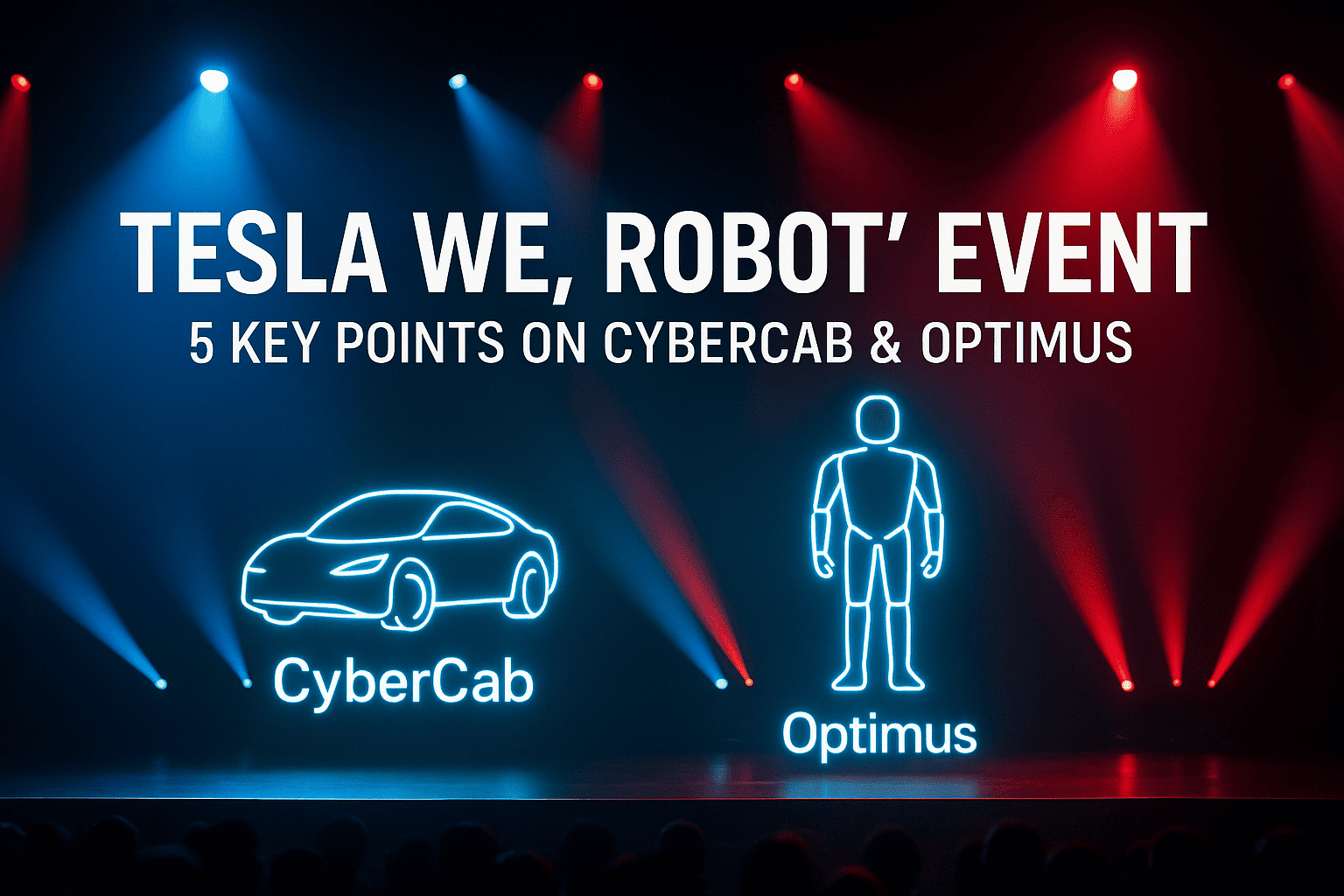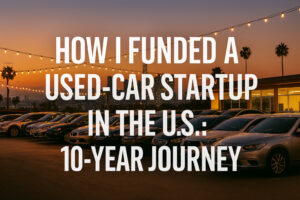Tesla ‘We, Robot’ Event: 5 Key Points on CyberCab & Optimus

Tesla’s 2024 “We, Robot” Event — Full Breakdown
Hi, Suzuki here from Eco Drive.
On October 10 Tesla hosted its much-anticipated AI & Robotics showcase, and the headline news was a game-changing update on the company’s Robotaxi program.
The event took place on the Warner Bros. studio lot in California and packed in five major announcements.
The videos embedded in this article are narrated in Japanese, but English subtitles are available.
1. CyberCab — Tesla’s Breakthrough Robotaxi

The star of the show was the very first public look at Tesla’s “CyberCab” robotaxi.
Note: the image above is not the CyberCab itself.
True to Tesla form, the prototype looks ultra-simple and sharply styled. My guess? What we saw is almost exactly what will hit the road.
The biggest shock: no steering wheel, no pedals—nothing for a human to drive.
And while Tesla didn’t say it outright, there were no visible door handles either, suggesting the doors will open automatically.
Falcon-Style Doors That Swing Upward
Instead of the usual side-hinged doors, CyberCab uses an overhead “gull-wing” design.
I find that choice brilliant.
My own Tesla Model X has Falcon-wing rear doors, and they’re incredibly practical—easy to open in tight parking spots and great for loading kids or luggage.
Bringing that same upward-opening layout to a robotaxi should make passenger entry and exit fast, safe, and almost futuristic.
Fully Automated Charging & Cleaning
Tesla didn’t share exact range numbers, but the operational concept itself is just as intriguing.
CyberCab will drive itself to a charging depot and even to a purpose-built wash bay—no human hands required.
Whenever the vehicle gets dirty, it will automatically head to a dedicated facility where both the exterior and the cabin are cleaned and sanitized before the next ride.
Massive Cost Savings on the Horizon
The real headline here is cost.
Tesla projects an operating expense of about 20 cents per mile.
That’s a jaw-dropping number when you consider that an L.A. city bus costs roughly $1 per mile to run.
With costs that low, Tesla could charge riders, say, 50 cents a mile and still make a healthy margin.
Imagine cutting your transit fare in half versus today’s bus prices—ridership could skyrocket.
Tesla also said each CyberCab should sell for under $30,000, with production slated for the second half of 2026.
2. Built-In Wireless Charging
The second announcement was a genuine surprise.
CyberCab is designed for wireless charging.
Most EVs still juice up via a plug-in cable, but Tesla’s robotaxi will have no external charge port at all. Instead, it will top up through a contact-free pad—think smartphone charging, scaled up for a car.
If Tesla pulls this off, it would upend the industry’s entire approach to EV charging.
3. RoboVan — Tesla’s Vision for Shared Transit
The third reveal was the 20-seat “RoboVan.”
A prototype is already built, and it looks production-ready—complete with an Iron-Man-style front fascia.
Like CyberCab, the RoboVan has no steering wheel and no pedals; it’s designed for full autonomy from day one.
Tesla showed rows of passenger seats and a large cabin display, but stopped short of saying whether the van will be sold to fleets or run as a Tesla-operated shuttle service.
We’ll be watching closely for the next round of details.
4. Marching Toward Level-5 Autonomy
The fourth headline was Tesla’s long-awaited road map to true Level-5 self-driving.
Today’s Full Self-Driving is a “Supervised” system—classified as Level 2—because a human still has to keep hands on the wheel and eyes on the road.
Tesla says the next milestone will be an “Unsupervised” version that jumps straight to Level 5.
Level 5 means zero human oversight: you could nap, stream a movie, or read a book while the car does everything.
Tesla plans to push this update in 2025, starting with the Model 3 and Model Y.
The first rollout zones will be California and Texas, with more regions to follow once regulators sign off
5. Optimus — Tesla’s Humanoid Robot, Version 2.0
The finale was all about Tesla’s humanoid robot, Optimus—now shown in an upgraded build.
You may remember its first outing at the last shareholder meeting; this version is clearly a step up.
Optimus strode on stage on two feet and even danced in time with the music, wowing the audience.
The most striking part was how incredibly fluid the joints looked—far smoother than anyone expected.
Tesla also demoed Optimus pulling bartender duty, pouring a beer with steady precision.
Powered by on-board AI, the robot already feels like a fully fledged humanoid assistant.
Elon Musk put the target price in the $20,000–$30,000 range when Optimus eventually goes on sale.
Where Tesla Is Headed Next
This event made one thing crystal-clear: Tesla has outgrown the label “car company.”
It’s morphing into an AI-driven technology firm—and a robotics manufacturer—rolled into one.
The robotaxi roadmap, in particular, feels game-changing.
With CyberCab expected to sell for around $30 k a unit, we’ll likely see fleets owned and operated by companies rather than individual drivers.
That shift could unleash a wave of deregulation in the taxi space, forcing today’s giants—Uber, Lyft, and traditional cab outfits—to navigate the biggest industry shake-up in decades.
Level-5 Autonomy Will Upend Auto Insurance—and How We Think About Cars
The rise of true self-driving will force a complete rethink of auto insurance.
Today, you buy a personal policy, you shoulder the liability, and your premium swings up or down based on your own accident record.
But when Level-5 cars appear, the big question becomes: Who’s really at fault?
Is it the manufacturer, the software provider, the human sitting in the seat, or the fleet owner that actually pays the bill?
Where that liability lands will decide who writes the check for coverage—and could reshape the entire insurance industry.
Could Robotaxis Turn Cars into an Investment Asset?
The widespread rollout of autonomous taxis could also flip the script on how we value cars.
Right now, a personal vehicle is mainly a cost center—or a hobby—depreciating roughly 50 % over the first three years.
But if that same vehicle starts earning revenue as a robotaxi, it suddenly looks more like income-producing real estate than a rapidly depreciating asset.
In that scenario, cars could become investment properties that hold their value far better than today’s privately owned rides.
Will Tesla Eventually License Its Full Self-Driving Tech?
One of the most intriguing questions now is whether Tesla will start licensing FSD to rival brands.
Tesla has been honing its self-driving stack for more than a decade, feeding it vast quantities of real-world data.
Given that head start, it may be nearly impossible for traditional automakers to catch up from scratch.
Paying a licensing fee and dropping Tesla’s mature FSD system into their own cars could be the faster, more cost-effective route.
From my own seat time with FSD, the software keeps getting better month after month—a trajectory that only widens Tesla’s lead.
Curious what FSD V12 feels like on the road? Check out my hands-on review here.
A Future Where Humanoid Robots Are Part of Everyday Life
Tesla’s Optimus humanoid robot carries enormous potential.
Elon Musk has called it a “big-business project,” and it really could spark a new kind of gold rush.
Home use is where Optimus might shine first.
Our houses, furniture—even room layouts—are designed for human bodies, so a human-shaped robot can navigate them far more efficiently than any other form factor.
From everyday chores—cleaning, cooking, walking the dog, watching the kids—to acting as a personal mentor or advisor, the use cases are huge.
Need career guidance, homework help, or a quick business brainstorm? Ask Optimus.
Out of the house? Fire up the app and say, “Keep an eye on the kids” or “Run the vacuum.” Life could look very different once a capable humanoid is only a voice command away.
Our Services
We offer comprehensive automotive solutions—buy, sell, rent, and repair in one place.
Car Sales
Browse our lineup of quality used cars with transparent pricing and up to a two-year warranty on select models.
View InventoryAuto Repair
Get expert service from our certified Toyota Master Mechanic. We primarily service Toyota vehicles.
Schedule ServiceTrade-in / Sell
We pay top dollar for your vehicle—especially hybrids. Count on fair, transparent appraisals.
Get EstimateCar Rentals
Choose between fuel-saving hybrid rentals and a Tesla with Full Self-Driving Capability—both at competitive rates.
Reserve Now





